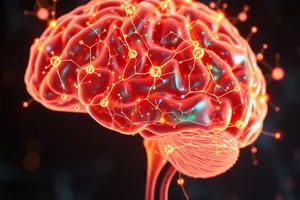Podcast
Questions and Answers
Qual è la definizione di flessibilità cognitiva?
Qual è la definizione di flessibilità cognitiva?
- La capacità di eseguire una sola attività alla volta senza distrazioni.
- La capacità di memorizzare una grande quantità di informazioni e richiamarle rapidamente.
- La capacità di mantenere l'attenzione su un singolo compito per un lungo periodo di tempo.
- La capacità di cambiare rapidamente l'attenzione da un compito all'altro, pensare in modo creativo e risolvere problemi complessi. (correct)
Quale area del cervello è stata associata alla flessibilità cognitiva?
Quale area del cervello è stata associata alla flessibilità cognitiva?
- Il cervelletto
- L'ippocampo
- La corteccia prefrontale (correct)
- L'amigdala
Cosa si intende per plasticità sinaptica?
Cosa si intende per plasticità sinaptica?
- La capacità dei neuroni di modificare la loro connettività in base all'esperienza. (correct)
- La capacità dei neuroni di rigenerare le proprie connessioni dopo un danno.
- La capacità dei neuroni di mantenere una connettività statica nel tempo.
- La capacità dei neuroni di trasmettere segnali elettrici senza alcuna modificazione.
Quali sono i principali meccanismi di plasticità sinaptica?
Quali sono i principali meccanismi di plasticità sinaptica?
Come la plasticità sinaptica è legata alla formazione della memoria?
Come la plasticità sinaptica è legata alla formazione della memoria?
In che modo la flessibilità cognitiva è legata alla plasticità cerebrale?
In che modo la flessibilità cognitiva è legata alla plasticità cerebrale?
Cosa si intende per 'neuroplasticit'?
Cosa si intende per 'neuroplasticit'?
Quale ruolo svolge la neuroplasticit nel funzionamento del cervello?
Quale ruolo svolge la neuroplasticit nel funzionamento del cervello?
Come avviene il processo di formazione della memoria?
Come avviene il processo di formazione della memoria?
Cosa si intende per Potenziamento a Lungo Termine (LTP)?
Cosa si intende per Potenziamento a Lungo Termine (LTP)?
Cosa si intende per Depressione a Lungo Termine (LTD)?
Cosa si intende per Depressione a Lungo Termine (LTD)?
Come contribuiscono il Potenziamento a Lungo Termine (LTP) e la Depressione a Lungo Termine (LTD) alla formazione della memoria?
Come contribuiscono il Potenziamento a Lungo Termine (LTP) e la Depressione a Lungo Termine (LTD) alla formazione della memoria?
Flashcards are hidden until you start studying
Study Notes
Introduction
Brain plasticity, also known as neuroplasticity, refers to the brain's ability to change its structure and function in response to internal and external stimuli, allowing for adaptation, learning, and recovery from injuries. This phenomenon is crucial for various aspects of brain function, including memory formation, cognitive flexibility, and synaptic plasticity.
Neuroplasticity
Neuroplasticity encompasses the changes that occur throughout life in the brain's structure, function, and chemistry, resulting from a combination of genetic factors and environmental influences. It plays a vital role in shaping the brain's wiring and enhancing its overall performance.
Memory Formation
Memory formation involves the strengthening and weakening of synaptic connections between neurons, which helps encode new information. Two main types of synaptic plasticity, Long-Term Potentiation (LTP) and Long-Term Depression (LTD), contribute to this process. LTP increases the strength of synaptic connections, making them more likely to fire together, thus promoting memory consolidation. On the other hand, LTD weakens the strength of synaptic connections, reducing their likelihood of firing together, helping to forget unimportant details. These processes enable the brain to selectively strengthen the connections associated with the memory while weakening those that are irrelevant, ensuring efficient storage and retrieval of information.
Cognitive Flexibility
Cognitive flexibility, also known as executive functioning, is the ability to switch focus between tasks, think creatively, solve complex problems, and regulate behavior according to social norms. Studies suggest that cognitive flexibility relies on dynamic processes involving neuroplastic changes in specific brain areas, such as the prefrontal cortex (PFC). This region exhibits significant structural changes throughout development and aging, potentially due to adaptive changes in synaptic connectivity and organization, which are crucial for flexible problem solving and social interaction.
Synaptic Plasticity
Synaptic plasticity is the molecular and cellular processes by which the strength of synaptic connections between neurons is modified due to experience or activity. This phenomenon occurs at both short and long time scales, with a range extending from milliseconds to days. Short-term synaptic plasticity affects the immediately available pool of synaptic transmitter release, while long-term plasticity involves persistent changes in gene expression and protein synthesis, leading to enduring alterations in synaptic strength and connectivity. Some well-studied forms of synaptic plasticity include Hebbian learning, which strengthens the connection between neurons that fire together, and metaplasticity, which modulates the capacity of synapses to express long-term plasticity.
Conclusion
In conclusion, brain plasticity is a fundamental property of nervous systems that underlies various aspects of neural function, including memory formation, cognitive flexibility, and synaptic plasticity. Understanding these processes can provide valuable insights into how the brain adapts to changing environments, learns new information, and recovers from injuries. Continued research on neuroplasticity may ultimately lead to novel therapies for neurological disorders and enhance our understanding of human cognition and behavior.
Studying That Suits You
Use AI to generate personalized quizzes and flashcards to suit your learning preferences.




